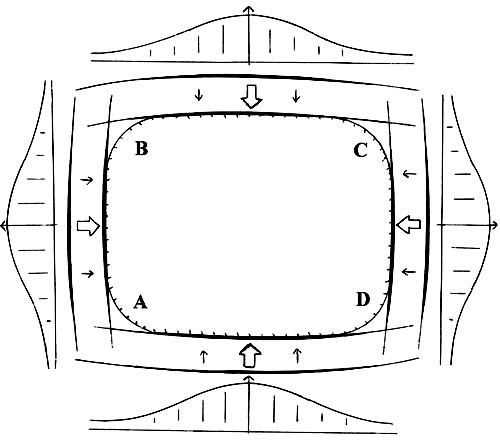
http: // shulga.tripod.com/A_SAD2/R.htm
| Russian |
ABSRTUCT
INTRODUCTION.
Conceptual content.
Line is one of primary geometrical concepts by means of which the man describes environmental actuality. An apparent ease - "evidence" - from which the man operates with his own abstract representations in this field makes false impression about simplicity of algorithmization (transposition into a computer) of such operation. One of key tasks here is a partition of registered linear shapes on individual components - the elementary segments. Difficulties start already in the elementary case - a case of "angular" polylines. It appears rather uneasy to pick out an angle in a actuality when lines are set discretely as a set of the individual points scattered around of their true positions.
In the first section
of the present work, the arising here difficulties are systematically considered. The physical sense of minimization
of mean-square deviation as the basic procedure of the analysis of actual
data is considered. Necessity of usage of the bell-like (fuzzy) function
of a membership of contour points to individual segment is obviously shown.
Tasks of partition of contour configuration on individual segments and
their approximation are reduced together - to searching local maxima of
a "fuzzy" measure of likeness constructed on the basis of such function.
The second section
considers a more complicated problem, namely, - if we should divide into units a lines having the smooth shapes,
when generally there are no precise angles, - one segment gradualy - smoothly
pass into another. The example of the figure outlined by a similar
line is shown on fig.I.

|
| Fig.I |
The gradual divergation is the basic moment which is necessary for including in a model of approximating shapes. The function estimating a membership of points to a individual segment should have the maximum in the centre of a the segment, and gradually reduce the value on its periphery. Such bell-like function enables to rest on the length of the contour lines for a maximum degree when they are approximated with the curves of some standard type, mainly in the center, with gradual weakening in the periphery direction, according to their gradual divergence. On fig.I, the linear images defined by the given concept are schematic shown. The diminution of their width (their thinning) responds to diminution of their geometrical determinancy - to clearness. Appropriate shapes of the bell-shaped membership function are figured from the exterior side of each segment.
It is visually possible
to represent that approximating is carried out with certain arcs - small
arcs with “thinning” to their ends (the association with typographical
round brackets is also pertinent). Such segments, or small
arcs, are named by contiguous segments because their branches,
in common, only adjoin to approximated lines. Their other semantic
title is segments with the fuzzy ends.
To the concept of contiguous segments - segments with
the fuzzy ends it is possible to approach on the other hand too -
not from a diminution of their determinancy on periphery, but, on
the contrary, - its magnifications to the centre. Magnification
of a geometrical determinancy to the centre - the middle - with adjoin
of branches is just that ensures a maximum of determinancy
in a definition of the tangential direction. Here, abstract differential
feature - a direction of a line in a point (the first derivative) obtains,
in face of contiguous segments, the stable foundation for the definition
in actual conditions. There is a potential possibility of wider practical
usage of this feature at the analysis of actual data.
In the third section,
the problem of practical usage of contiguous segments in the task
of positional detection of arbitrary formed contour objects under
their samples is considered. The offered solution is based on a procedure
of registration of unison of parametric (positional) hypotheses
about probable positions of sought configuration, which are independently
generated by separate primary features - fragments. As such indicators
(fragments) the contiguous segments here appear. A common ontological
(essential) scheme of such procedure is offered. Practical implementation
of this approach leads to the procedure of detection similar to procedures
in which basis the known Hough transform lays. The offered summarizing
enables to see their depth generality, to simplify logic of their development
and the further development.
Moreover, and what is above all, the developed procedure
is based on an application of the universal primary elements, which
limit the sets of the hypotheses about the global (positional) parameters
of the search objects in the maximum. It is applied the described
above tangent-contiguous segments with fuzzy ends. It was an use
of these initial units that enabled us to draw the carried
out search the hypothesis unison principle up to a possibility of
the constructive application in the problem of positional detection
of arbitrary form objects. In the other hand, it was the use of such
way of detection that enable a principal way to "cut up" the "sliding
uncertainty" of contiguous segments that have its place in general. It
may be told about unique unity of this conceptual pair.
At this base, the sequence of procedures was created
for efficient solving the problem of segmentation-approximation and
following positional detection (detection with definition of the position
and orientation) of arbitrary form flat contour figures with respect
to their samples in the case when one figure may partially overlap
another.
All these may be essentially advanced and widely applied
as the whole and individually.
TABLE OF CONTENTS:
3. THE UNISON OF PARAMETRIC HYPOTHESES AS THE INDICATOR OF POSITIONAL DETECTION.